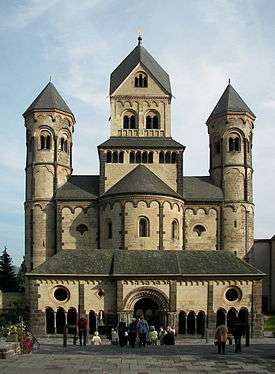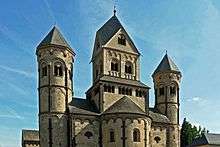Maria Laach Abbey


Maria Laach Abbey (in German: Abtei Maria Laach, in Latin: Abbatia Maria Lacensis or Abbatia Maria ad Lacum) is a Benedictine abbey situated on the southwestern shore of the Laacher See (Lake Laach), near Andernach, in the Eifel region of the Rhineland-Palatinate in Germany. It is a member of the Beuronese Congregation within the Benedictine Confederation. The abbey was built in the 11th-12th centuries and was originally known as "Abtei Laach" ("Abbatia Lacensis" or "Laach Abbey", meaning the "Lake Abbey") until 1862 when the Jesuits added the name "Maria".
First Benedictine foundation
Founded in 1093 as a priory of Affligem Abbey (in modern Belgium) by the first Count Palatine of the Rhine Heinrich II von Laach and his wife Adelheid von Orlamünde-Weimar, widow of Hermann II of Lotharingia, Laach became an independent house in 1127, under its first abbot, Gilbert. Affligem itself had been founded by Hermann. Although the abbey was founded by a prominent (although perennially excommunicated) member of the imperial party (Investiture Controversy), Affligem became soon after a prominent member of the Cluniac reform movement.
The abbey developed as a centre of study during the 12th century. The 13th-century abbots Albert (1199–1217) and Theoderich II (1256–1295) added significantly to the buildings and architectural decoration, including the monumental tomb of the founder.
In common with most other German Benedictine houses, Laach declined during the 14th century in terms of its spiritual and monastic life, a tendency which was reversed only in the late 15th century, under the influence of the reforming Bursfelde Congregation, which the abbey joined, supported against a certain resistance within the abbey by Abbot Johannes V von Deidesheim (1469–1491).
The consequent improvement in discipline led to a fruitful literary period in the abbey's history, prominent in which were Jakob Siberti, Tilman of Bonn and Benedict of Munstereifel, but principally Prior Johannes Butzbach (d. 1526). Although much of his work, both published and unpublished, survives, his chronicle of the abbey is unfortunately lost.
Secularisation and the Jesuits
Laach Abbey was dissolved in the secularisation of 1802. The premises became the property, first of the occupying French, and then in 1815 of the Prussian State.
In 1820 the buildings were acquired by the Society of Jesus, who established a place of study and scholarship here. Of particular note were Fathers Gerhard Schneemann, Theodor Granderath and Florian Reiss, who produced a number of important works: the "Collectio lacensis" ("Acta et decreta sacrorum conciliorum recentiorum", 7 volumes, Freiburg, 1870–1890); the "Philosophia lacensis", a collection of learned books on the different branches of philosophy (logic, cosmology, psychology, theodicy, natural law) and published at Freiburg, 1880–1900; and, perhaps best-known, the "Stimmen aus Maria-Laach" ("Voices from Maria Laach"), appearing from 1865, at first as individual pamphlets defending against liberalism within the Roman Catholic church, and from 1871 as a regular periodical. The Jesuits were obliged to leave during the "Kulturkampf" of the 1870s.
Second Benedictine foundation
The Benedictines of the Beuronese Congregation moved into the monastery in 1892, and it was raised into an abbey the following year. The restoration of the church, at that time still the property of Prussia, was inaugurated by Kaiser Wilhelm II in 1897.
In the first half of the twentieth century Maria Laach played a leading role in the Liturgical Movement.
The abbey structure dates from between 1093 and 1177, with a paradisium added around 1225 and is considered a prime example of Romanesque architecture of the Staufen period. Despite its long construction time the well-preserved basilica with its six towers is considered to be one of the most beautiful Romanesque buildings in Germany.
Due to a considerable reduction of the lake level in the early 19th century, serious and unexpected structural damages to the church vaults and roofs were detected. Three important renovation campaigns took place - the first in the 1830s to repair the structural damages including the removal of the paradisium's upper storey (it had an upper storey at that time for accommodation facilities), the second in the 1880s including repairs after a serious fire in the southern round tower in 1885, and the third in the 1930s. Many former changes to the buildings carried out in Gothic (e.g. steep tower roofs) and Baroque style (e.g. wider windows) have been re-altered to Romanesque style.
Controversial relations with the Nazi regime
The Maria Laach Abbey has been at the center of a controversy over its relations with the Nazi regime between 1933 and 1945. In particular Heinrich Böll, depicting in Billiards at Half-past Nine a Benedictine monastery whose monks actively and voluntarily collaborated with the Nazis, is generally considered to have had Maria Laach in mind.
In 2004 researcher Marcel Albert published Die Benediktinerabtei Maria Laach und der Nationalsozialismus ("The Maria Laach Benedictine Abbey and National Socialism").[1] In reviewing the book, Dr. Mark Edward Ruff of Saint Louis University wrote:[2]
The Benedictine abbey, Maria Laach, poses a number of interpretative challenges for historians writing on Roman Catholicism during the Third Reich. This influential monastery in the Eifel became known as a center for right-wing Catholicism already during the Weimar Republic. Its leaders enthusiastically greeted the Nazi seizure of power in 1933.
It was the only Benedictine monastery in the Rhineland not to be confiscated by the Nazi regime, even if part of the facility was converted into a hospital for wounded soldiers. Yet at the same time, it provided a sanctuary for Konrad Adenauer in 1934, who had been unceremoniously removed from his position as mayor of Cologne. In addition, its leaders became the target of numerous Gestapo interrogations, even as rumors spread that the monastery was to be appropriated by the state ...
Marcel Albert's book ... relies heavily on the unpublished memoirs of Ildefons Herwegen, a conservative monarchist who served as abbot of Maria Laach until his death in 1946. At times self-serving, these memoirs provide the narrative thread for this book.
Albert quotes extensively from these, all the while commenting on the accuracy and reliability of Herwegen's account. He also makes extensive use of the archival holdings of the monastery itself, supplementing these with official state and police reports ...
Maria Laach became a focal point in the Weimar Republic for those right-wing Catholics disillusioned by the collapse of the Hohenzollern monarchy and outraged at the Catholic Centre Party's coalitions with the Social Democrats (SPD). The monks, politicians, businessmen, theologians and students who gathered there were strongly influenced by the idea of a coming 'Reich', hoping to build a third Holy Roman Empire.
Such prominent conservatives as Emil Ritter, Carl Schmitt - later to gain notoriety as the "Crown Jurist of the Third Reich" - and Charles Edward, Duke of Saxe-Coburg and Gotha, renegade member of the British aristocracy, all participated in events sponsored by the monastery. ... The Benedictines here attracted members of the Catholic aristocracy, those who were more receptive to the right-wing nationalist movements of the time.
Not surprisingly, both Herwegen and many others at Maria Laach embraced Hitler's regime and even chided other Catholics for failing to work with the new state. "Blood, soil and fate are the appropriate expressions for the fundamental powers of the time," Herwegen avowed. The rise of the Third Reich was part of the workings and designs of God. Hitler's promise to build Germany on a Christian foundation on March 21, 1933 led several monks to hang a picture of Hitler in the abbey and to unfurl the black white red flag of the bygone Kaiserreich.
As late as 1939, one of the members of the abbey, an artist who had converted to Catholicism, P. Theodor Bogler, published a "Briefe an einen jungen Soldaten," (Letters to a young soldier) in which he let loose a virulently anti-Jewish polemic.
This openness to National Socialism by many at Maria Laach did not go unnoticed by the Nazi press. Robert Ley's Westdeutsche Beobachter reported that "one knows that the spirititual-religious educational work of the Benedictines of Maria-Laach for years has increasingly viewed itself responsible for all of the duties to renew the national conscience."
Yet the Nazis did not always reciprocate the embrace of the monks. Instead, the Gestapo began to interrogate the monks, arresting one monk on charges of homosexuality. The printing of Alfred Rosenberg's "Myth of the 20th Century" (advocating Positive Christianity, which was actually based on pantheistic pagan nature worship and Teutonic Gods), as well as the political demotion of Franz von Papen, forced Herwegen already in 1934 to temper his hopes of exerting a Christian influence on the new state.
Although the monastery was not closed down, as were all other Benedictine abbeys in the area, its members had become a regular target of state attacks. Albert makes it clear, however, that it was only the Nazi persecution of the churches, and not the attacks on the Jews or Nazi military aggression, that forced Herwegen to see the regime in a new light.
Similarly, Herwegen housed Adenauer for almost a year in his abbey not necessarily because he agreed with the Center Party politician's Weltanschauung, but because Adenauer was a childhood friend from his days at school ...
In its closing chapters, the book shows that the abbey cultivated a positive relationship to Adenauer and the CDU after 1945, but retained its monarchist beliefs. However, the post-war parts of the book are less extensive, and this part of the monastery's history seems to await further research.
Basilius Ebel
Born Henri Ebel in 1896 as son of a wine-producing family from Alsace, and later a significant scholar of his times, Dr. Basilius Ebel became abbot of St. Matthias' Abbey in Trier in 1939 and provided a sanctuary to Jews whom he admitted among the monks. In 1941, his abbey was confiscated by the Gestapo and he himself was exiled to Maria Laach where he became abbot from 1946 to 1966. Under his leadership, Maria Laach became an important centre of reconciliation between Christians and Jews.
On the scholarly side, he should be remembered for publishing a 12th-century Alemannic hymnal[3] and for the restoration of the Maria Laach basilica to its original style.
Notable features

The abbey church of Maria Laach is considered a masterpiece of German Romanesque architecture,[4] with its multiple towers, large westwork with arcaded gallery, and unique west porch.
The east end has a round apse flanked by twin square towers. Over the transept crossing is a broad cupola with cone-shaped roof. The monumental west façade includes a west choir with apse flanked by round twin towers and a square central tower.
The Paradise, a single-story, colonnaded west porch surrounding a small courtyard, was added in about 1225. It recalls the architecture of Early Christian basilicas. Its capitals are richly carved with human and mythical figures. The imaginative mason is known as the Laacher Samson-Meister or "Master of the Laach Samson", whose carvings are also found in Cologne and elsewhere. The Lion Fountain in the courtyard was added in 1928.
Notable features of the interior include the tomb of the founder Pfalzgraf Heinrich II (dating from 1270), 16th-century murals, a Late Romanesque baldachino in the apse, and interesting modern decorations such as mosaics from c. 1910 and stained glass windows from the 1950s.
References
- ↑ Marcel Albert, "Die Benediktinerabtei Maria Laach und der Nationalsozialismus", Schoningh Verlag, Paderborn, 2004, 261 pp, ISBN 3-506-70135-5
- ↑ Mark Edward Ruff, "Book Review", in Association of Contemporary Church Historians (Arbeitsgemeinschaft kirchlicher Zeitgeschichtler), June 2006, Vol. XII, no. 6, University of British Columbia, (Editor: John S. Conway).
- ↑ Das alteste alemannische Hymnar mit Noten, Kodex 366 Einsiedeln (XII. Jahrhundert), Einsiedeln: Benziger, 1930
- ↑ Roger Stalley, Early Medieval Architecture (Oxford History of Art) (1990), p. 37.
External links
| Wikimedia Commons has media related to Maria Laach. |
- (in German) Official site
- Maria Laach Abbey
- Image: the St Nicholas icon
- Image: the Abbey gardens
- Image: Members of the congregation

![]()